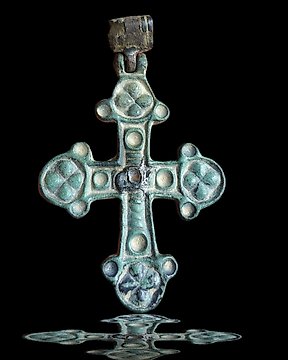
Bizantino bronce: excelente cruz con patina verde esmeralda natural Amuleto - Con enganche de suspensió
N.º 75054151

N.º 75054151

Very nice Figure Aegis of the god Khnum
Ancient Egpyt, Late Period, 664 - 323 BC
Dimensions: 10 cm heigth, 8,5 cm broad and 4 cm thickness. (without stand).
Material: Bronze.
Condition: Good, perfect. Small hollow in the sun disk.
Provenance: Private collection, L. F., Paris, acquired before 1970. After, public auction, 2023.
PARALLEL: You can see a parallel in the Fondation Gandur pour l'Art, Geneve, inv. FGA-ARCH-EG-0568. (see last photo). https://onlinecollections.fg-art.org/eMP/eMuseumPlus?service=direct/1/ResultListView/result.t1.collection_list.$TspTitleImageLink.link&sp=10&sp=Scollection&sp=SfilterDefinition&sp=3&sp=2&sp=1&sp=SdetailList&sp=75&sp=Sdetail&sp=0&sp=F&sp=T&sp=89
An aegis is a collarlike necklace (often called a broad-collar) bearing a divine head as symbol of protection and fertility. The aegis was an element of a sacred menat necklace from at least the 18th dynasty. Heads of Lion- or cat-headed goddesses were most frequently depicted, but other goddesses and some gods might appear.
Khnum, also spelled Khnemu, ancient Egyptian god of fertility, associated with water and with procreation. Khnum was worshipped from the 1st dynasty (c. 2925–2775 BCE) into the early centuries CE. He was represented as a ram with horizontal twisting horns or as a man with a ram’s head. Khnum was believed to have created humankind from clay like a potter; this scene, with him using a potter’s wheel, was depicted in later times. The god’s first main cult centre was Herwer, near Al-Ashmūnayn in Middle Egypt. From the New Kingdom (1539–1075 BCE) on, however, he was the god of the island of Elephantine, near present-day Aswān, and was known as the lord of the surrounding First Cataract of the Nile River. At Elephantine he formed a triad of deities with the goddesses Satis and Anukis. Khnum also had an important cult at Esna, south of Thebes.
The seller guarantees that he acquired this piece according to all national and international laws related to the ownership of cultural property. Provenance statement seen by Catawiki.
Cómo comprar en Catawiki
1. Descubre algo especial
2. Haz la puja más alta
3. Paga de manera segura